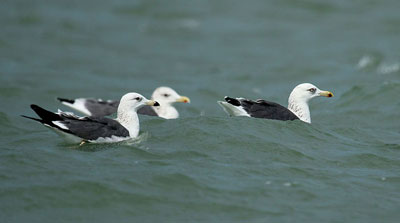


Guenter Lamsfuss
In 1996 and 2003 I wrote papers for the Ceylon Bird Club Notes dealing with the white-headed gulls Larus of the larger argentatus/fuscus complex which may occur as winter visitors in India and Sri Lanka. At that time there was great confusion about these birds, and the knowledge of their distinctive features as well as of their wintering grounds was rather poor. As a result, a wide range of species and subspecies was discussed as possible visitors to India and Sri Lanka. Moreover, the taxonomic classification of the members of this gull group was under discussion and subsequently underwent comprehensive revision.
 Meanwhile, scientific research has significantly improved the knowledge of these birds, and the taxonomy may soon settle. New literature such as Olsen & Larsson's Gulls of Europe, Asia and North America and Rasmussen & Anderton's Birds of South Asia: the Ripley Guide has been pub-lished. In consequence, the number of species recorded as winter visitors in the Indian region has thinned out considerably. Thus, the time seems now right for a new summary.
Meanwhile, scientific research has significantly improved the knowledge of these birds, and the taxonomy may soon settle. New literature such as Olsen & Larsson's Gulls of Europe, Asia and North America and Rasmussen & Anderton's Birds of South Asia: the Ripley Guide has been pub-lished. In consequence, the number of species recorded as winter visitors in the Indian region has thinned out considerably. Thus, the time seems now right for a new summary.
In India and Sri Lanka the situation has become rather easy. Only two forms of regular winter visitors are left: heuglini and barabensis. The taxonomic assignment of these and other forms is dealt with below. All other forms such as armenicus, cachinnans, fuscus, michahellis, mongolicus, taimyrensis, birulai and vegae are unconfirmed and considered 'hypothetical in region'. In fact, the former records of cachinnans, mongolicus and taimyrensis in India have turned out to be based on wrong identifications. The re-examination of specimens revealed that all records of cachinnans and mongolicus are actually barabensis, while those of taimyrensis are heuglini (Rasmussen & Anderton 2005). It seems that so far there is not a single definite record of any species other than barabensis and heuglini in the Indian region.
A recent photo documentation of adult large white-headed gulls wintering at Okha, a village where fishing activities occur in Gujrat, India in late January 2004 clearly assigns the majority of birds to barabensis and heuglini. Only three individuals in a flock of c. 1,200 were left unidentified and could not be assigned to either of the two forms. Judging by their late moult, they must have originated in the Arctic and could thus be taimyrensis, birulai or vegae (Buchheim 2006).
It is worth mentioning that armenicus and cachinnans as well as parts of the fuscus and taimyrensis populations are known to winter in the Gulf area and in western parts of the Arabian Sea. Reports of armenicus, cachinnans and fuscus on western Indian coasts suggest that occasional or accidental visits of these forms to India are possible, but none have been confirmed so far. Mongolicus and vegae are known to winter on the Pacific coasts of eastern Asia and therefore are not expected to show up in India. Parts of taimyrensis winter in the same area.
Although vagrants of species other than barabensis and heuglini to Sri Lanka cannot be entirely excluded, the probability of such visits is low. Moreover, it is evident that due to the difficulties in field identification, any definite record of such species could only be claimed on the basis of either a specimen or a ring recovery. This is especially true of immature birds which are even more difficult to identify. Nevertheless, a series of good close-up photographs of adult birds could be quite useful.
As far as the taxonomy is concerned, the members of the larger argentatus/fuscus complex have received comprehensive revision, and many former subspecies of this group are now treated as full species. This is true of Larus armenicus Armenian Gull, L. cachinnans Caspian Gull, L. heuglini Heuglin's Gull, L. michahellis Yellow-legged Gull and L. vegae Vega Gull. However, the taimyrensis/birulai/vegae group is still under discussion, with taimyrensis and birulai not being fully recognized as subspecies: taimyrensis is considered a hybrid form of heuglini and birulai, and birulai an indistinct (western) form of vegae. Besides, the heuglini/barabensis/cachinnans group is also still under discussion, and so is cachinnans/mongolicus, with a strong tendency to treat barabensis and mongolicus as full species too. For the time being mongolicus is commonly treated as a race of Caspian Gull L. cachinnans, while the classification of barabensis is varied: it is treated as a race of Heuglins's Gull in Rasmussen & Anderton and of Caspian Gull in Olsen & Larsson.
In consequence, barabensis makes things again a little more complicated in India and Sri Lanka. While according to Rasmussen & Anderton the birds which occur in the area are two races of one species, according to Olsen & Larsson they are two species. Each book gives good reasons for its point of view. The light-grey backed form barabensis breeds in the steppe areas of western Siberia, just north-east of the breeding grounds of the Caspian Gull which it resembles to a high degree, while the dark-backed Heuglin's Gull is a bird of the arctic tundra. On the other hand, barabensis is genetically almost identical with heuglini.
For practical ornithological use, it is certainly easier to follow Olsen & Larsson and treat barabensis as a race of cachinnans, as both are of very similar appearance. As in the past, this would mean that there are two species in Sri Lanka, namely the grey-backed Caspian Gull L. cachinnans in its race barabensis, and the dark-backed Heuglin's Gull L. heuglini.
Meanwhile, the situation is about to change again as barabensis is already recognized as a full species by some authors (e.g Clements 2005). With the general acceptance of this taxonomic change matters will be clear and easy: the Steppe Gull (sometimes also called Baraba Gull) L. barabensis, and Heuglin's Gull L. heuglini are the two species which are regular winter visitors to Sri Lanka.
Acknowledgement
I am grateful to Mr T W Hoffmann for reading the manuscript.
References
Buchheim A (2006) Adult large white-headed gulls at Okha, Gujrat, India: a photo documentation BirdingASIA 5: 40-53
Clements J F (2005) Birds of the World: a Checklist 5th ed. update. Christopher Helm
Lamsfuss G (1996) On the larger gulls as winter visitors to India and Sri Lanka Ceylon Bird Club Notes 1996: 39-44
Lamsfuss G (2003) On the white-headed gulls wintering in India and Sri Lanka: a supplementary note Ceylon Bird Club Notes 2003: 123-126
Olsen K M & Larsson H (2004) Gulls of Europe, Asia and North America Reprint with corrections. Christopher Helm
Rasmussen P C & Anderton J A (2005) Birds of South Asia: the Ripley Guide Vols.1-2. Smithsonian Institution & Lynx Edicions.